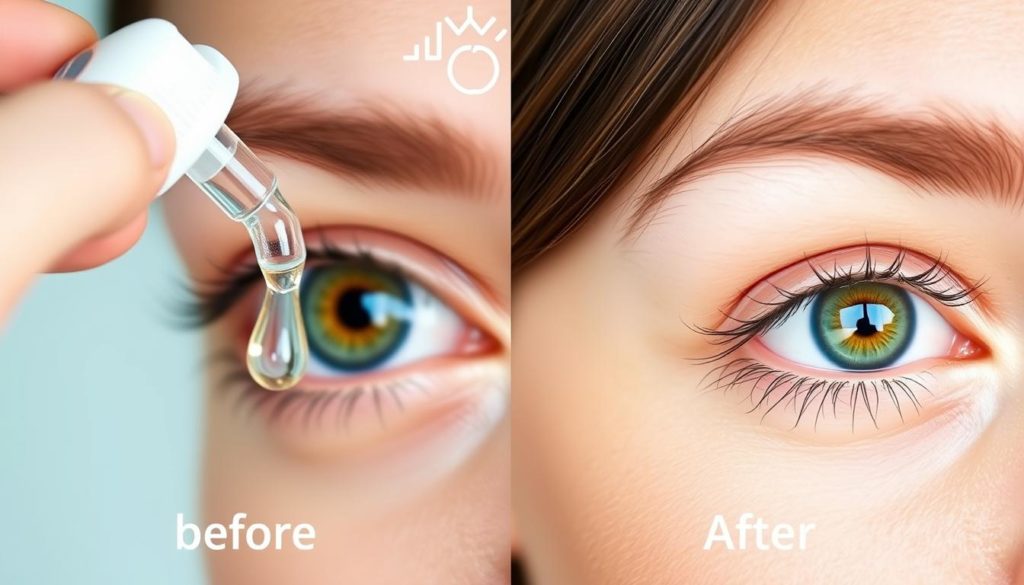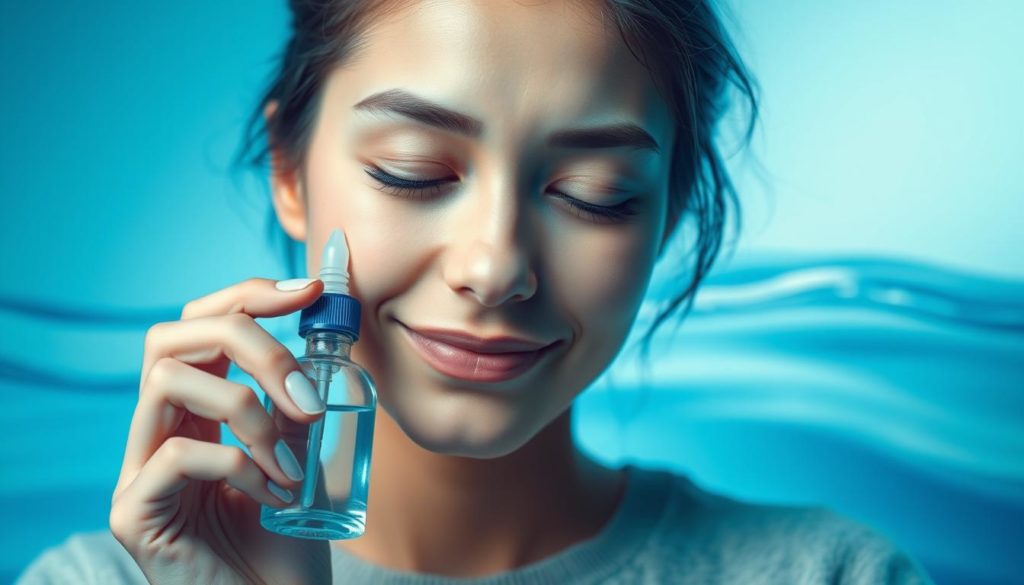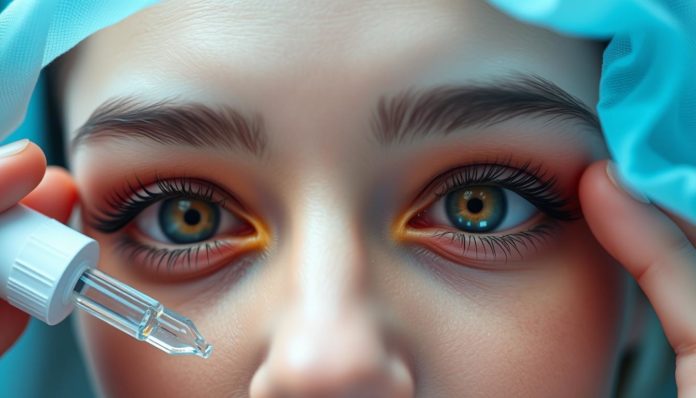Did you know over 61 million Americans have blurry vision due to eye problems? Eye drops can be a simple fix for many eye health issues. They help with dryness, reduce redness, and can even improve your vision.
Eye drops are often made with saline or medication. They’re great for adding moisture to dry eyes. This helps prevent discomfort. But that’s not all. Some drops are medicated and can help with allergies, glaucoma, or infections.
These drops don’t just offer quick relief. They can actually make your vision and eye health better.
Introduction to Eye Drops
Eye drops are a common solution for many eye problems. They help with dry eyes, reduce redness, and treat infections. Knowing the different types and uses can help you pick the right one for you.

Types of Eye Drops
There are many kinds of eye drops, each with its own purpose. Here are some of the most common:
- Lubricating drops: These are mainly for dry eyes relief. They add moisture to the eyes, boosting ocular health.
- Anti-allergic drops: These drops ease eye allergy symptoms, like itching and redness.
- Antibiotic drops: They treat bacterial infections in the eye.
- Glaucoma treatment drops: These drops lower the pressure inside the eye to manage glaucoma.
- Redness-reducing drops: These drops make red eyes less noticeable by shrinking blood vessels.
Common Uses
Eye drops are very versatile, used for many things:
- Moisturizing dry eyes: Lubricating drops offer dry eyes relief and boost ocular health.
- Allergy relief: Anti-allergic drops ease symptoms like itching and redness.
- Redness reduction: Special drops lessen the look of red eyes.
- Treating infections: Antibiotic drops are used to fight bacterial infections.
- Managing glaucoma: Certain drops control the pressure inside the eye for glaucoma.
Here’s a quick look at their main features:
| Type of Eye Drop | Main Use | Key Benefit |
|---|---|---|
| Lubricating Drops | Dry Eyes Relief | Enhanced Moisture |
| Anti-Allergic Drops | Allergy Relief | Reduced Itching |
| Antibiotic Drops | Treating Infections | Elimination of Bacteria |
| Glaucoma Drops | Managing Glaucoma | Reduced Intraocular Pressure |
| Redness-Reducing Drops | Redness Reduction | Soothing Red Eyes |
The Benefits of Eye Drops
Eye drops help with many eye problems. They make eyes feel better and work for different issues.
Relief from Dry Eyes
Eye drops are great for dry eyes. This can happen from being outside, staring at screens a lot, or taking some medicines. They add moisture to the eyes, making them feel better.
Using these drops often can also help heal dry eyes.
Allergy Relief
Eye drops can ease allergy symptoms too. They have ingredients like antihistamines or NSAIDs. These drops help with burning, stinging, and watery eyes from allergies.
They are key for keeping eyes comfortable when you have allergies.
Redness Reduction

Red eyes can be fixed with redness-relieving drops. These drops have decongestants that make blood vessels smaller, reducing redness. But, use them carefully to avoid problems later.
Eye drops are useful for many eye issues. They help keep eyes comfortable and deal with common problems like dryness and allergies.
Lubricating Eye Drops: A Closer Look
Lubricating eye drops help by acting like the eyes’ natural tears. They keep the eyes moist and reduce irritation. Knowing how they work and when to use them can improve your eye care.
How They Work
Lubricating eye drops copy the natural tear film of the eyes. This is key for keeping moisture and protecting against irritants. The drops, or artificial tears, add a layer of lubrication. This reduces dryness and makes your eyes more comfortable.
Using them often, especially without preservatives, lowers the chance of irritation.
When to Use Them
Use lubricating eye drops when you feel your eyes are dry, gritty, red, or uncomfortable. They’re great for people who are on computers a lot, in air-conditioned spaces, or outside in windy weather. Keeping your eyes moist helps prevent serious problems and keeps your eyes healthy.
Types of Lubricating Eye Drops
There are many kinds of lubricating eye drops for different needs. Standard artificial tears are good for most people. But, there are also special ones for contact lens users or those needing extra lubrication. Choosing the right drops can really help your eye health and hydration.
Anti-Allergy Eye Drops Explained
Eye allergies can be tough to handle, but anti-allergy eye drops can help. These drops are made to fight off symptoms from allergens like pollen, pet dander, and dust. They help keep your eyes healthy.
Common Ingredients
Antihistamines are a main part of anti-allergy eye drops. They stop histamines from acting out during an allergic reaction. Some drops also have nonsteroidal anti-inflammatory drugs (NSAIDs) to lessen swelling and ease discomfort.
Brands like Visine-A and Zaditor are well-known for their effectiveness against allergies.
Seasonal Use
For many, allergy season means dealing with red, itchy, and watery eyes. Anti-allergy eye drops are in high demand in spring and summer when pollen counts are up. Using these drops can quickly ease symptoms, making outdoor activities more enjoyable.
Adding these drops to your daily routine during allergy season can greatly boost your eye health.
Preservative-Free Eye Drops: Are They Better?
Preservative-free eye drops are popular among those looking for gentle eye care. They are great for people with sensitive eyes. These drops are safe for daily use, lowering the chance of irritation and allergic reactions.
Benefits of Preservative-Free
Preservative-free eye drops are a big win for sensitive eyes. They don’t have preservatives, so they’re less likely to irritate or cause allergic reactions. Each drop comes in a single-use vial, keeping it clean and safe.
- Reduced risk of irritation
- Lower chance of allergic reactions
- Safe for frequent use
When to Choose Preservative-Free
If you have sensitive eyes or need eye drops often, go for preservative-free. They’re perfect for chronic dry eyes or glaucoma. These options offer gentle care without harsh additives.
| Suitable Conditions | Benefits |
|---|---|
| Chronic Dry Eyes | Reduced irritation and safe for frequent use |
| Glaucoma | Gentle on sensitive eyes |
| Allergic Reactions | Lower chance of allergens causing problems |
Potential Risks of Overusing Eye Drops
When using eye drops, it’s key to know the risks and keep your eyes safe. Using them too much can cause serious problems.
Rebound Redness
Using eye drops with vasoconstrictors too often can lead to rebound redness. This means the redness gets worse after you stop using the drops. It makes the problem seem worse than it was before.
Masking Underlying Conditions
Using eye drops too much without a doctor’s advice can hide real eye problems. This can delay finding and treating these issues. It can lead to bigger health problems.
How to Avoid Overuse
To prevent these issues, follow the right steps when using eye drops. Choose drops without preservatives if you need them often. Always talk to an eye doctor if your symptoms don’t go away.
| Risk | Explanation | Prevention |
|---|---|---|
| Rebound Redness | Redness that worsens after stopping drops. | Use only as directed and consult a professional. |
| Masking Underlying Conditions | Conceals chronic or severe eye problems. | Seek medical advice for persistent issues. |
| Incorrect Eye Drops Usage | Using eye drops too frequently or improperly. | Follow usage instructions carefully. |
How to Properly Use Eye Drops
Using eye drops correctly is key for their effectiveness and your safety. The right technique makes sure the medicine or lubricant goes where it needs to. This helps keep your eyes healthy. Let’s look at the step-by-step guide and some tips, especially for contact lens users.
Step-by-Step Guide
- Wash Your Hands: Begin by washing your hands well with soap and water to avoid contamination.
- Prepare the Drop: If needed, shake the bottle, and then take off the cap without touching the dropper tip.
- Form a Pocket: Tilt your head back a bit, and pull down your lower eyelid with one hand to make a small pocket.
- Apply the Drop: Hold the dropper over your eye and squeeze out one drop into the pocket without touching your eye with the dropper.
- Close Your Eye: Close your eye gently and press the inner corner to stop the liquid from going into your tear duct. Blink a few times to spread the drop evenly.
- Repeat If Necessary: If you need more drops, wait a bit and repeat as needed.
Tips for Contact Lens Wearers
- Remove Lenses First: Always take out your contact lenses before applying eye drops, unless you’re using a lens-specific drop.
- Wait Before Reinsertion: After putting in eye drops, wait at least 15 minutes before putting in your lenses again. This lets the drops absorb fully.
- Maintain Lens Hygiene: Keeping your lenses clean and stored right is key for your eye health.
- Check Compatibility: Make sure your eye drops won’t harm your contact lenses. Some drops have preservatives that can build up on lenses.
Following these steps and tips will help you get the relief and efficiency you want from eye drops. It also keeps your eyes healthy, especially if you wear contact lenses often.
Medicated Eye Drops for Specific Conditions
Medicated eye drops are often prescribed for specific eye conditions. They provide targeted treatment and relief from symptoms. These drops are key for managing various eye problems safely and effectively.
Glaucoma Treatment
For glaucoma management, medicated eye drops are crucial. They help lower the pressure inside the eye. This is important to protect the optic nerve and prevent vision loss.
Common ingredients in these drops include prostaglandins, beta-blockers, and carbonic anhydrase inhibitors.
Using these drops as part of your glaucoma management plan is important. Follow the guidelines closely to get the best results and avoid side effects.
Antibiotic Eye Drops
Antibiotic eye care is vital for fighting bacterial eye infections. These drops target the specific bacteria causing the infection. They usually contain ingredients like erythromycin, tobramycin, and ciprofloxacin.
It’s important to get a proper diagnosis from a doctor. This ensures you get the right antibiotic eye care. It helps treat the infection and relieve symptoms.
Here’s a quick comparison to sum up the differences between glaucoma treatment and antibiotic eye drops:
| Condition Treated | Purpose | Common Ingredients |
|---|---|---|
| Glaucoma | Reduce intraocular pressure | Prostaglandins, Beta-blockers, Carbonic anhydrase inhibitors |
| Bacterial Infections | Eliminate infection-causing bacteria | Erythromycin, Tobramycin, Ciprofloxacin |
Consult an Eye Care Professional
If you’re having ongoing or serious eye problems, it’s key to see an eye doctor. They know how to spot and treat eye issues accurately. This ensures you get the right care for your eyes.
At a visit, an eye doctor will do a full eye check-up. This might include tests for your vision, looking for eye diseases, and checking how well treatments like eye drops are working. Getting eye conditions diagnosed right means you can get the right treatment fast. This helps prevent more problems and keeps your eyes healthier.
Also, getting advice from an eye expert is safer than treating yourself. Using the wrong eye drops or ignoring eye problems can make things worse. By seeing an eye doctor, you make sure your eyes are cared for by a pro. They focus on keeping you healthy and your eyes in top shape.
FAQ
What are the types of eye drops available?
Eye drops come in many types, like lubricating, anti-allergy, antibiotic, and for glaucoma. Each type is made for different eye problems.
What are the benefits of using lubricating eye drops?
Lubricating eye drops act like the eye’s natural tears. They add moisture and comfort to dry eyes. This makes them great for dry eyes relief.
When should I choose preservative-free eye drops?
Use preservative-free eye drops if you have sensitive eyes or use eye drops often. They are less likely to irritate your eyes. They come in single-use vials for safety.
Can eye drops help with allergy symptoms?
Yes, anti-allergy eye drops can ease symptoms like burning and watering eyes during allergy seasons. They work by reducing inflammation for quick relief.
What are the risks of overusing eye drops?
Using eye drops too much, especially those with vasoconstrictors, can make your eyes look redder when you stop. It can also hide real eye problems, delaying the right treatment.
How should I properly apply eye drops?
To apply eye drops right, wash your hands first. Don’t touch the dropper tip. Use a pocket-forming technique for the drops. If you wear contact lenses, take them out before applying drops and wait to put them back in.
What are the benefits of eye drops for glaucoma treatment?
Eye drops for glaucoma lower pressure inside the eye to protect the optic nerve. This reduces the risk of blindness. They are key in managing glaucoma.
Why is it important to consult an eye care professional?
Seeing an eye care professional helps get the right diagnosis and treatment. They guide you to avoid self-treatment risks. This ensures your eye health is well managed.


